Hypocretin/orexin neurons contribute to hippocampus-dependent social memory and synaptic plasticity in mice
- PMID: 23516292
- PMCID: PMC3640412
- DOI: 10.1523/JNEUROSCI.3200-12.2013
Hypocretin/orexin neurons contribute to hippocampus-dependent social memory and synaptic plasticity in mice
Abstract
Hypocretin/orexin (Hcrt)-producing neurons in the lateral hypothalamus project throughout the brain, including to the hippocampus, where Hcrt receptors are widely expressed. Hcrt neurons activate these targets to orchestrate global arousal state, wake-sleep architecture, energy homeostasis, stress adaptation, and reward behaviors. Recently, Hcrt has been implicated in cognitive functions and social interaction. In the present study, we tested the hypothesis that Hcrt neurons are critical to social interaction, particularly social memory, using neurobehavioral assessment and electrophysiological approaches. The validated "two-enclosure homecage test" devices and procedure were used to test sociability, preference for social novelty (social novelty), and recognition memory. A conventional direct contact social test was conducted to corroborate the findings. We found that adult orexin/ataxin-3-transgenic (AT) mice, in which Hcrt neurons degenerate by 3 months of age, displayed normal sociability and social novelty with respect to their wild-type littermates. However, AT mice displayed deficits in long-term social memory. Nasal administration of exogenous Hcrt-1 restored social memory to an extent in AT mice. Hippocampal slices taken from AT mice exhibited decreases in degree of paired-pulse facilitation and magnitude of long-term potentiation, despite displaying normal basal synaptic neurotransmission in the CA1 area compared to wild-type hippocampal slices. AT hippocampi had lower levels of phosphorylated cAMP response element-binding protein (pCREB), an activity-dependent transcription factor important for synaptic plasticity and long-term memory storage. Our studies demonstrate that Hcrt neurons play an important role in the consolidation of social recognition memory, at least in part through enhancements of hippocampal synaptic plasticity and cAMP response element-binding protein phosphorylation.
Figures

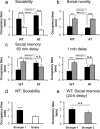
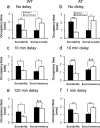
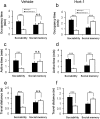
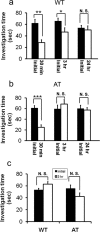
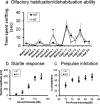
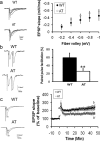

Similar articles
-
Orexin B/hypocretin 2 increases glutamatergic transmission to ventral tegmental area neurons.Eur J Neurosci. 2008 Oct;28(8):1545-56. doi: 10.1111/j.1460-9568.2008.06397.x. Epub 2008 Sep 10. Eur J Neurosci. 2008. PMID: 18793323
-
Hypocretin/orexin and nociceptin/orphanin FQ coordinately regulate analgesia in a mouse model of stress-induced analgesia.J Clin Invest. 2008 Jul;118(7):2471-81. doi: 10.1172/JCI35115. J Clin Invest. 2008. PMID: 18551194 Free PMC article.
-
Thyrotropin-releasing hormone increases behavioral arousal through modulation of hypocretin/orexin neurons.J Neurosci. 2009 Mar 25;29(12):3705-14. doi: 10.1523/JNEUROSCI.0431-09.2009. J Neurosci. 2009. PMID: 19321767 Free PMC article.
-
Hypocretin modulation of drug-induced synaptic plasticity.Prog Brain Res. 2012;198:123-31. doi: 10.1016/B978-0-444-59489-1.00008-2. Prog Brain Res. 2012. PMID: 22813972 Review.
-
Hypocretin/orexin in arousal and stress.Brain Res. 2010 Feb 16;1314:91-102. doi: 10.1016/j.brainres.2009.09.019. Epub 2009 Sep 11. Brain Res. 2010. PMID: 19748490 Free PMC article. Review.
Cited by
-
Chronic Anatabine Treatment Reduces Alzheimer's Disease (AD)-Like Pathology and Improves Socio-Behavioral Deficits in a Transgenic Mouse Model of AD.PLoS One. 2015 May 26;10(5):e0128224. doi: 10.1371/journal.pone.0128224. eCollection 2015. PLoS One. 2015. PMID: 26010758 Free PMC article.
-
Discovery of Arylsulfonamides as Dual Orexin Receptor Agonists.J Med Chem. 2021 Jun 24;64(12):8806-8825. doi: 10.1021/acs.jmedchem.1c00841. Epub 2021 Jun 8. J Med Chem. 2021. PMID: 34101446 Free PMC article.
-
Regulatory Role of Orexin in the Antistress Effect of "Press Tack Needle" Acupuncture Treatment.Healthcare (Basel). 2021 Apr 27;9(5):503. doi: 10.3390/healthcare9050503. Healthcare (Basel). 2021. PMID: 33925438 Free PMC article.
-
The potential role of the orexin system in premenstrual syndrome.Front Endocrinol (Lausanne). 2024 Jan 16;14:1266806. doi: 10.3389/fendo.2023.1266806. eCollection 2023. Front Endocrinol (Lausanne). 2024. PMID: 38292774 Free PMC article. Review.
-
Decreased serum orexin A levels in drug-naive children with attention deficit and hyperactivity disorder.Neurol Sci. 2019 Mar;40(3):593-602. doi: 10.1007/s10072-018-3692-8. Epub 2019 Jan 7. Neurol Sci. 2019. PMID: 30617449
References
-
- Aguirre M, Broughton R, Stuss D. Does memory impairment exist in narcolepsy-cataplexy? J Clin Exp Neuropsychol. 1985;7:14–24. - PubMed
-
- Akbari E, Naghdi N, Motamedi F. The selective orexin 1 receptor antagonist SB-334867-A impairs acquisition and consolidation but not retrieval of spatial memory in Morris water maze. Peptides. 2007;28:650–656. - PubMed
-
- Borgland SL, Taha SA, Sarti F, Fields HL, Bonci A. Orexin A in the VTA is critical for the induction of synaptic plasticity and behavioral sensitization to cocaine. Neuron. 2006;49:589–601. - PubMed
-
- Bourtchuladze R, Frenguelli B, Blendy J, Cioffi D, Schutz G, Silva AJ. Deficient long-term memory in mice with a targeted mutation of the cAMP-responsive element-binding protein. Cell. 1994;79:59–68. - PubMed
Publication types
MeSH terms
Substances
Grants and funding
LinkOut - more resources
Full Text Sources
Other Literature Sources
Molecular Biology Databases
Miscellaneous
